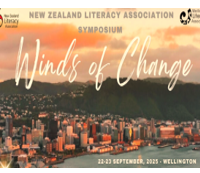Learnings from Inspiring the Reading and Writing ai??i?? What is critical for reluctant readers and writers?ai??i?? Dr Murray Gadd
May 2017 – Inspiring the Reading and Writing ai??i?? What is critical for reluctant readers and writers?ai??i?? Dr Murray Gaddai??i??
Wow, what an opportunity to be able to listen to someone so passionate and knowledgeable in the field of literacy. Murrayai??i??s presentation was centred around: Inspiring Reading and Writing ai??i?? What is critical for all learners? With a focus, also on the underachieving and reluctant learners.
Murray started by covering who our underachievers and reluctant learners are likely to be: boys, non NZE students and English Language Learners. Whether this is due to a lack of confidence, or that students just do see the relevance and are unable to make connections, or they simply do not understand what has been asked of them, it still remains that they are the vulnerable ones. He presented ideas about how we as teachers can be effective in ensuring that these students can achieve success in this very important learning and life area.
One of the things that has stuck with me since the presentation was a question that Murray suggested we ask our students regularly: ai???Of everything Iai??i??ve taught you, what was the most effective?ai??i?? For me this really made an impact as it should be what drives everything we do and say as teachers. He also talked about the questioning and probing we do as teachers, do we simply use surface level questioning that just ticks boxes, or, do we delve deeper and really get our students thinking critically about the ideas and conversations we are having in the classroom? Murray went on to suggest that to get the students more involved in the learning we ask them, ai???What task could we do, or would you like to do on this theme/learning area?
In his research, Murray identified eight dimensions of effective practice that have the biggest impact on student learning. The eight dimensions are: expectations, learning goals, learning tasks, direct instruction, responding to students, engagement and challenge, organisation and management and lastly, self-regulation. Murray also found that a select few of these dimensions had a greater impact still, especially when combined with high teacher proficiency. Strongly impacting learner gains were; learning tasks and direct instruction, and decreasing the achievement gap were; self-regulation, responding to students and organisation and management.
So, how do we as teachers implement these dimensions in our literacy programs so as to increase engagement, motivation and to provide challenges to our learners? Firstly, we must select texts and topics carefully, considering students interests, personal experiences and instructional levels, while also looking for opportunities for cross-curricular links. Murrays research also found that by including the students in the decision-making process for text selection and themes for writing was a great motivator and engaged students because they had something to say on the topic.
Secondly, we need to have clear learning goals for all lessons, reading or writing, that have been co-constructed with the students so that the learning is visible to all. Knowing what skills will be required to complete tasks and learning how to do these is also important as otherwise success could be difficult for some. Another important aspect to ensure success that effective teachers do, is demonstrate the learning processes and outcomes, which can be both active and receptive. This fundamentally shows the students that we are active members of the teaching/learning community, problem solvers and risk takers ai??i?? we all make mistakes and have the opportunity to correct them. We also need to be asking our students a range of questions that require them to think deeply and go beyond the surface. In other words, we need to get our students thinking meta-cognitively, not just skimming the surface. Teachers need to adjust their questioning to suit the level of their studentai??i??s ability, while at the same time differentiating instructions depending on the needs of individuals or groups at that point and time in their learning. In other words, we need to be flexible and willing to change direction in a lesson at any given moment; we need to know our students.
Murray ended his presentation with some excellent examples of organisational ideas for literacy programs and the suggestion that children should be silent reading for a sustained period of 20 minutes per day. Another couple of questions to ask our students in the literacy session are; Where are you up to? And, what are you going to work on today? This helps us as teachers to gauge the where, when, what and how of the lessons: what do our students need from us in that lesson? This really was a fantastic and worthwhile event, with so many examples of how to implement changes to ensure success for all students. Many of CLA members have had very positive feedback from those who attended and we are looking forward to the next event.
Rachel McLaughlin





